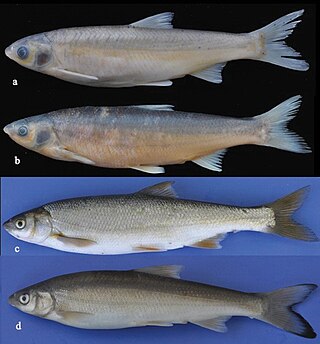Capoeta antalyensis, also known as the Antalya barb or Pamphylian scraper, is a species of freshwater fish in the family Cyprinidae. It is found only in Turkey in the Aksu and Köprüçay River drainages, which flow south into the Gulf of Antalya in the Mediterranean. Its lives in swiftly flowing stretches of rivers, but also found in lakes. It is threatened by habitat loss.

Capoeta, also known as scrapers, is a genus of fish in the family Cyprinidae found in Western Asia. The distribution extends from Turkey to the Levant, to Transcaucasia, Iraq, Turkmenistan, in Armenia, particularly in lake Sevan and northern Afghanistan. This genus is most closely related to Luciobarbus and in itself is divided into three morphologically, biogeographically and genetically distinct groups or clades: the Mesopotamian clade, the Anatolian-Iranian clade and the Aralo-Caspian clade. The Mesopotamian clade was split off to Paracapoeta in 2022.
Capoeta bergamae is a species of freshwater cyprinid fish native to Turkey. The species is also known as the Aegean scraper.
Capoeta pestai, called the Eğirdir longsnout scraper or the Eğirdir barb, is a critically endangered freshwater fish species in the family Cyprinidae, found only in Turkey. It used to be common across Lake Eğirdir in central Anatolia, but survives only in one of the inflowing rivers. It was forced out of Lake Eğirdir by a combination of overfishing, irrigation, destruction of its habitat, and the induction of predatory alien fish species.

Chondrostoma kinzelbachi, commonly known as the Orontes nase or Levantine nase, is a species of nase, a genus of cypriniform fish within the cyprinid subfamily Leuciscinae. It is endemic to the Orontes River basin, historically occurring in Turkey and Syria. It is a fairly small freshwater fish, ranging from 11.8 centimetres (4.6 in) to 21.6 centimetres (8.5 in) SL.

Pseudophoxinus is a genus of fish in the family Cyprinidae found in Western Asia.
Salmo macrostigma is a species of freshwater trout endemic to Algeria in northwest Africa. It can reach a length of 60 centimetres (24 in) TL.
Capoeta banarescui. the Colchic scraper or Banarescu's barb, is a species of cyprinid fish known from Turkey. It inhabits swiftly flowing water with cobbles and pebbles bottom.
Paracapoeta barroisi, also known as the Orontes scraper or Tigris barb, is a species of freshwater cyprinid fish from the Near East. This species is up to 20 cm (7.9 in) long and has sides with brownish spots irregularly arranged in the upper half of the body.
Capoeta caelestis, the Taurus scraper, is a species of freshwater cyprinid fish endemic to southern Anatolia, Turkey. It has a max length of 19.6 cm (7.7 in) long.

Capoeta damascina, the Levantine scraper or Mesopotamian barb, is a species of cyprinid fish from the Near East region. It is reported from Iraq, Israel, Jordan, Lebanon, Syria, Iran and Turkey.
Capoeta sieboldii, also called the nipple-lip scraper, is a cyprinid fish species from Turkey. It is widespread and lives in a range of habitats that are at least seasonally connected to rivers or streams. The distribution is from the Sakarya River eastwards, to western Transcaucasia.
Capoeta tinca, or the Anatolian khramulya or western fourbarbel scraper, is a species of cyprinid fish endemic to Turkey, inhabiting swiftly flowing rivers.
Paracapoeta trutta, the longspine scraper or spotted scraper, is a species of cyprinid fish from the Middle East. It is known from inland waters in Iran, Iraq, Syria, Armenia and Turkey, and is often quite abundant.
Oxynoemacheilus frenatus, the banded Tigris loach, is a species of ray-finned fish in the genus Oxynoemacheilus. This species is widespread in the upper drainage basin of the Tigris in Turkey, Syria and Iraq where it can be locally very common. It can be found in habitats varying from streams with a moderately fast current to near standing waters in springs, streams and rivers which have beds of gravel or mud. Academically speaking, it inhabits fast-flowing streams and rivers with rocky substrates.
Turan's goby is a Ponto-Caspian species of goby endemic fish native to Turkey where it is only found in the Aksu Deresi stream. This species is found in a fresh water stream with a substrate of rounded pebbles. Males of this species can reach a length of 8.8 centimetres (3.5 in) SL while females only reach 8.3 centimetres (3.3 in) SL.
Salmo opimus is a salmonid fish in the genus Salmo. It was described by Davut Turan, Maurice Kottelat and Semih Engin in 2012, and is known from Turkey. The type locality was the Alara Stream in Gündoğmuş, Antalya Province. The species epithet, "opimus" refers to the large body size of the adults.

The Manyas spirlin is a species of minnow that is endemic to the Simav River drainage of Lake Kuş, also known as Lake Manyas, in Turkey. It may become threatened as its range is densely inhabited and increasingly industrialized.
The Arsuz bleak is a species of freshwater cyprinid fish found in rivers draining into the Gulf of İskenderun, including the Seyhan River and Ceyhan River in Turkey.

Paracapoeta is a genus of fish in the family Cyprinidae found in Mesopotamia, Cilicia and the Levant, Western Asia. This genus is closely related to Luciobarbus and was formerly the Mesopotamian clade of Capoeta before being split off in 2022. The generic name alludes to παρά meaning "near" and Capoeta.







